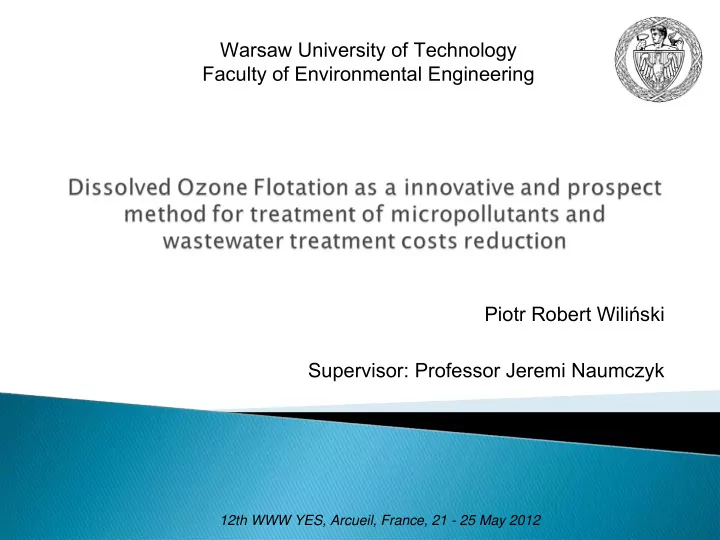

Warsaw University of Technology Faculty of Environmental Engineering Piotr Robert Wili ń ski Supervisor: Professor Jeremi Naumczyk 12th WWW YES, Arcueil, France, 21 - 25 May 2012
AGENDA • Dissolved Air Flotation (DAF) vs. Dissolved Ozone Flotation (DOF) • Possible enhancements in water/wastewater tratment by DOF • Aims of the project • Materials and Methods • Results • Merits and demerits of DOF • Research plan • Conclusions 12th WWW YES, Arcueil, France, 21 - 25 May 2012
Dissolved Air Flotation - theory • separation of liquid and particles • fat, oils, suspended solids, coloids (after agglomeration) removal • mining industry, water and wastewtaer treatment • conventional flotation – bubbles ~ 100-300 μ m micro- and nanoflotation ~ 5-20 μ m • pre-treatment of industrial wastewaters (dairy, fruit& vegetable, paper etc.), separation of excess activated sludge and effluent • coagulation and flocculation needed before separation Figure 1. Scheme of DAF unit 12th WWW YES, Arcueil, France, 21 - 25 May 2012
Dissolved Air Flotation vs. Dissolved Ozone Flotation theory Feature Feature DAF DAF DOF DOF feeding gas oxygen, air ozone + oxidizing ability +++++ (only oxygenation) TSS reduction +++++ ++++ COD reduction ++ ++++ BOD reduction ++ ++++ . biodegrability of effluent the same Improved/higher compare to influent small amounts or coagulants and needed flocculants dosing not needed Figure 2. DAF/DOF testing unit external equipment not needed ozone generator 12th WWW YES, Arcueil, France, 21 - 25 May 2012
Possible enhancements in water/wastewater tratment by DOF • removal of micropollutants, odour removal • increase of pollutants biodegradability in wastewater • reduction of wastewater treatment costs by reducing the footprint of biological treatment step • reduction in chemicals (coagulants and flocculants) dosing • the algae removal from water to prepare it to potable water conditions / algae harvesting for further usage (biofuel, pharmaceuticals, animal’s food etc.) • reduction of the excess sludge generation – DOF for final separation 12th WWW YES, Arcueil, France, 21 - 25 May 2012
Aims of the project • to examine the effectiveness of a combination of two processes: micro- and nanoflotation with ozonation • to examine technical and operational factors affecting the process (bubbles size, pH conditions, coagulant and flocculant addition) • to examine treatment efficiency of the DOF process compare to DAF process in case of treatment fracturing fluids, industrial wastewater and water containing algae • to choose trace micro-pollutant (i.e. biocide in used fracturing fluid) and check its removal efficiency by DOF with comparison with DAF method • to examine the potential reduction of operating costs and treatment efficiency • to research the influence of ozone on potential increase of wastewater biodegradability 12th WWW YES, Arcueil, France, 21 - 25 May 2012
Materials and Methods • laboratory flotation unit/ pilot testing (ozone generator 10g/h, DAF –Nikuni pump, flotation unit V=150L) • physiochemical and technical parameters influence - pH, temperature - bubbles size (ozone mass transfer) - ozone dosage, oxidation rate vs. economy, - process kinetics • chemical analysis - COD, BOD, TOC, TSS removal - biodegrability and toxicity • chromatography: GC or HPLC for detailed analysis of chemical compounds transformation 12th WWW YES, Arcueil, France, 21 - 25 May 2012
Results • apple processing plant, Q=1 400m 3 /d – • at the moment: sieve DAF – biological treatment (activated sludge) • DAF: iron(III) sulfate and anionic polymer (optifloc) Following reductions: • COD: 20.1 % DAF – 33.8% DOF • BOD: 20.3% DAF – 34.8% DOF • TSS: 66.6% DAF – 45.2% DOF • oxidation yield: 0,07gO 3 / 1gBOD /dm 3 23mgO 3 12th WWW YES, Arcueil, France, 21 - 25 May 2012
Results % reduction for Parameter Unit After DAF After DOF DOF compared to DAF Reactor size m 3 3 807 3 587 5.8 Oxygen demand kgO 2 /h 105.2 129.0 18.5 Nm 3 /h Air demand 3 150 3 870 18.6 Energy demand for aeration (air blower kWh 110 130 15.4 motor power) Excess sludge kg/d 1 816 1 648 9.3 production • ATV method for dimensionig of biological treatment step • biological reactor: high: 6.0m; process temperature 15°C • total savings: 32 000 €/ year (lower energy consumption, iron (III) sulfate dosing, lower sludge production 12th WWW YES, Arcueil, France, 21 - 25 May 2012
Merits and demerits of DOF 1) Merits: • more efficient water/ wastewater treatment • reduction of biological treatment step, reduction of excess sludge production • elimination of micropollutants • synergy of mechanical treatment and ozonation in one unit • possible cost reduction (coagulants, smaller biological plants) 2) Demerits • control of excessive ozone – ozone sensors • materials needed to construct resistant unit • price of ozone generators 12th WWW YES, Arcueil, France, 21 - 25 May 2012
Research plan • design and construction of laboratory flotation testing unit • research on defining process parameters • research on the wastewater from selected industries and fracturing fluids • research on water containing algae • elaboration of the results and publication in journals • further questions and possible research aspects . 12th WWW YES, Arcueil, France, 21 - 25 May 2012
Conclusions Results • DOF more effective for COD and BOD removal than DAF • TSS removal higher for DAF – polymer adjustment needed • prospect pre-treatment method Further research • more harmful wastewater i.e. fracturing fluids, cosmetics wastewater Further laboratory test would be focused on checking process efficiency in case of removal selected micropollutants i.e. biocide, wastewater toxicity. • kinetics, pollutants transformation, factors affecting the process, process parameters 12th WWW YES, Arcueil, France, 21 - 25 May 2012
Warsaw University of Technology Faculty of Environmental Engineering Piotr Robert Wili ń ski e-mail: piotr.wilinski@is.pw.edu.pl Supervisor: Professor Jeremi Naumczyk 12th WWW YES, Arcueil, France, 21 - 25 May 2012
Recommend
More recommend